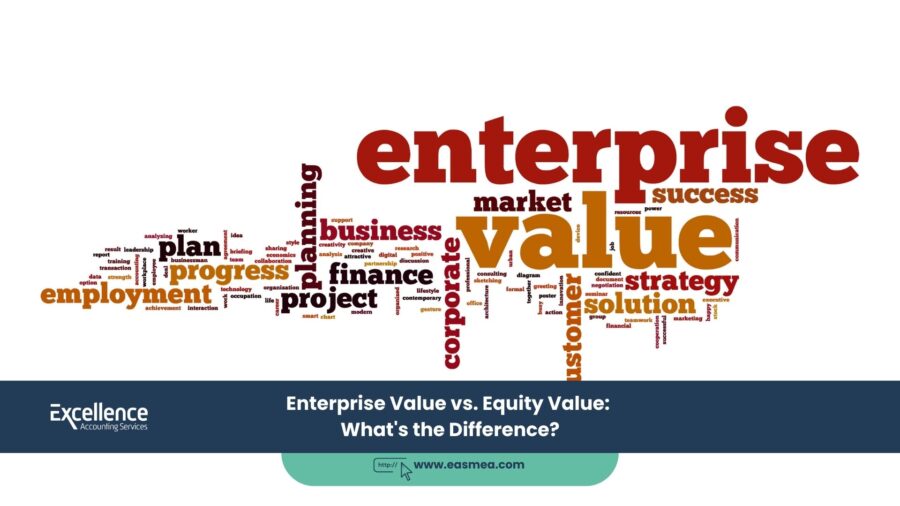Enterprise Value vs. Equity Value: What’s the Difference?
In the world of finance, investment, and M&A, few concepts are as fundamental—and as frequently confused—as **Enterprise Value** and **Equity Value**. While they are related, they represent two distinct perspectives on a company’s worth. Understanding the difference is not just an academic exercise; it’s essential for investors, business owners, and anyone involved in a corporate transaction to accurately assess value, compare companies, and negotiate deal terms.
- Enterprise Value vs. Equity Value: What's the Difference?
- What is Equity Value? The Shareholder's Perspective
- What is Enterprise Value (EV)? The Total Company Perspective
- Clarity in Valuation with Excellence Accounting Services (EAS)
- Frequently Asked Questions (FAQs)
- Planning a Transaction? Understand the True Value.
In simple terms, Equity Value is the value of the company that belongs to its shareholders. Enterprise Value represents the total value of the company’s core business operations, attributable to all capital providers (both equity and debt). Think of it like buying a house: the Enterprise Value is the total sale price, while the Equity Value is the amount you, the owner, get to keep after paying off the mortgage.
This guide will provide a clear and practical explanation of the difference between these two critical valuation metrics. We will break down how each is calculated and explain why both are essential for a complete understanding of a company’s value.
Key Takeaways
- Equity Value is for Shareholders: It represents the value of the company’s shares and is the number most relevant to equity investors. It’s often called Market Capitalization for public companies.
- Enterprise Value is for All Capital Providers: It represents the total value of a business’s operations, including the claims of both debt and equity holders. It is considered the theoretical “takeover price.”
- The Bridge: Debt and Cash. The primary difference between the two is the treatment of debt and cash. To get from Equity Value to Enterprise Value, you add debt and subtract cash.
- Enterprise Value is “Capital Structure-Neutral”: Because it includes debt, EV is a better metric for comparing similar companies that have different levels of debt financing.
- Both are Essential: You need to understand both metrics to get a complete picture. A professional business valuation will always analyze and present both.
What is Equity Value? The Shareholder’s Perspective
Equity Value is the most straightforward of the two concepts. It represents the total value of a company that is attributable to its equity shareholders. For a publicly traded company, this is commonly known as **Market Capitalization** or “Market Cap.”
How to Calculate Equity Value:
For a public company:
Equity Value = Current Share Price x Total Number of Fully Diluted Shares Outstanding
For a private company, the Equity Value is typically derived from a broader valuation process, often by first calculating the Enterprise Value and then adjusting it.
What is Enterprise Value (EV)? The Total Company Perspective
Enterprise Value (EV) provides a more comprehensive measure of a company’s total worth. It represents the value of the entire business, independent of its capital structure. It can be thought of as the theoretical price an acquirer would have to pay to buy the entire business—paying off all the debt holders and buying out all the equity holders.
How to Calculate Enterprise Value:
The calculation is a “bridge” from Equity Value:
Enterprise Value = Equity Value + Total Debt - Cash & Cash Equivalents
Other components, such as Preferred Stock and Minority Interest, are also added if they exist.
- Why do we add debt? Because when an acquirer buys a company, they also assume its debts. Therefore, the debt is part of the total cost of the acquisition.
- Why do we subtract cash? Because the acquirer gains access to the company’s cash, which can be used to immediately pay down the newly acquired debt or pay a dividend. Therefore, the cash on hand reduces the net cost of the acquisition.
A Practical Example: The Bridge Calculation
Let’s consider a company with the following details:
- Share Price: AED 20
- Shares Outstanding: 10 million
- Total Debt: AED 50 million
- Cash on Hand: AED 20 million
| Component | Calculation | Value (AED) |
|---|---|---|
| Equity Value (Market Cap) | AED 20/share x 10 million shares | 200,000,000 |
| (+) Add: Total Debt | Given | 50,000,000 |
| (-) Subtract: Cash & Cash Equivalents | Given | (20,000,000) |
| Enterprise Value (EV) | Equity Value + Debt – Cash | 230,000,000 |
Clarity in Valuation with Excellence Accounting Services (EAS)
Understanding the nuances of Enterprise and Equity Value is fundamental to any significant financial transaction. At EAS, our advisory services are built on providing this clarity to our clients.
- Independent Business Valuation: We provide comprehensive valuation reports that clearly articulate both the Enterprise and Equity Value of a business, using multiple methodologies for a defensible conclusion.
- M&A Due Diligence: Our due diligence process is designed to verify the numbers that feed into these calculations—confirming the true levels of debt, cash, and sustainable earnings.
- Transaction Advisory: Our CFO services team advises on deal structuring and negotiation, ensuring you understand how every adjustment to the “bridge” will impact the final price you pay or receive.
Frequently Asked Questions (FAQs)
Because it is “capital structure-neutral.” Two companies might be identical in their operations, but if one is financed with a lot of debt and the other is financed purely with equity, their Equity Values will be very different. Their Enterprise Values, however, will be very similar. This makes EV a much better metric for an apples-to-apples comparison of core business performance.
Yes. This happens when a company has a large amount of cash and very little or no debt. If the cash on the balance sheet is greater than the total debt, the Enterprise Value will be lower than the Equity Value (Market Cap).
Net Debt is a company’s Total Debt minus its Cash and Cash Equivalents. The Enterprise Value formula can also be written as: EV = Equity Value + Net Debt.
The type of value must match the type of earnings metric. Equity Value is paired with metrics that are *after* interest payments (like Net Income, which gives the P/E ratio). Enterprise Value is paired with metrics that are *before* interest payments (like EBITDA or EBIT, which gives the EV/EBITDA ratio). EV/EBITDA is often preferred by analysts because, like EV itself, it is independent of capital structure.
No. The book value of equity (or Shareholders’ Equity) is an accounting concept based on historical costs. Equity Value (or Market Cap) is a market-based concept that reflects what investors are willing to pay for the company’s future prospects. For a healthy, growing company, the market-based Equity Value is almost always significantly higher than the book value.
The headline price announced in the media is often the Enterprise Value because it’s a larger, more impressive number. However, the actual amount of cash that the selling shareholders receive is the Equity Value, which is calculated after adjusting the EV for the company’s debt and cash at the time of closing.
Yes, though it is rare. A negative EV means that a company’s cash balance is greater than the combined value of its market cap and its debt. This can happen with companies in financial distress or those with very large cash hoards and low market valuations.
These are highly liquid, short-term investments that can be converted into cash very quickly (typically within 90 days). Examples include treasury bills and commercial paper. They are treated the same as cash in the EV calculation.
If a company owns more than 50% of a subsidiary but less than 100%, it consolidates 100% of that subsidiary’s financials (like revenue and EBITDA). Minority Interest represents the portion of the subsidiary that the parent company does not own. It is added back to EV to ensure that the valuation multiples (like EV/EBITDA) are consistent, as the numerator (EV) and the denominator (EBITDA) both reflect 100% of the subsidiary.
For a private company, the process is reversed. A valuator will typically first calculate the Enterprise Value using methods like Discounted Cash Flow (DCF) or by applying market multiples (like EV/EBITDA from public companies) to the private company’s EBITDA. They will then work backward from the calculated EV to arrive at the Equity Value by subtracting debt and adding cash.
Conclusion: Two Sides of the Same Coin
Enterprise Value and Equity Value are not competing metrics; they are complementary perspectives that, together, provide a complete picture of a company’s worth. Equity Value tells the shareholders what their stake is worth, while Enterprise Value provides a holistic view of the business’s total operational value. Mastering the distinction and the relationship between these two concepts is a fundamental skill for any serious investor or business leader.
Planning a Transaction? Understand the True Value.
Contact Excellence Accounting Services for an independent business valuation that brings clarity to both your Enterprise and Equity Value.




